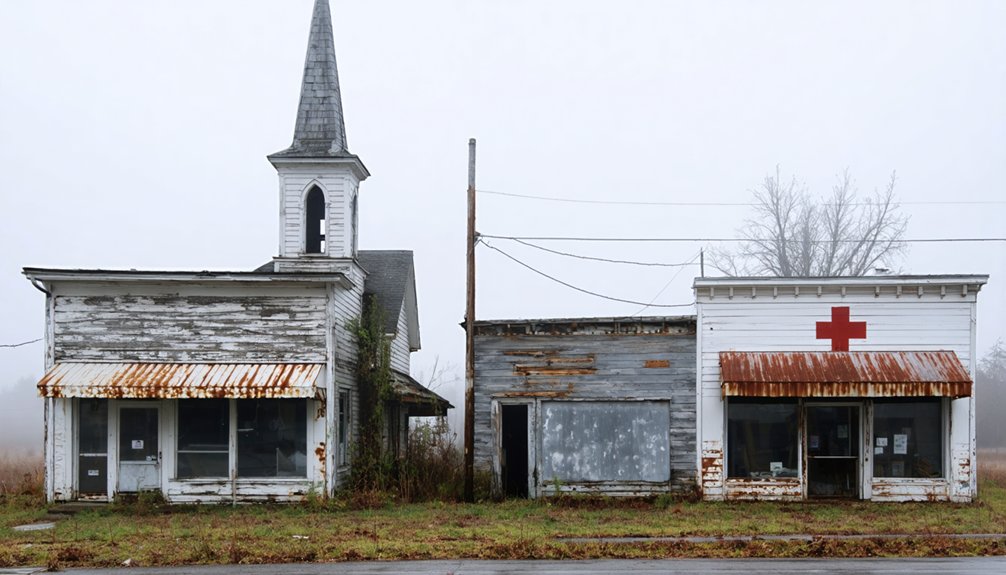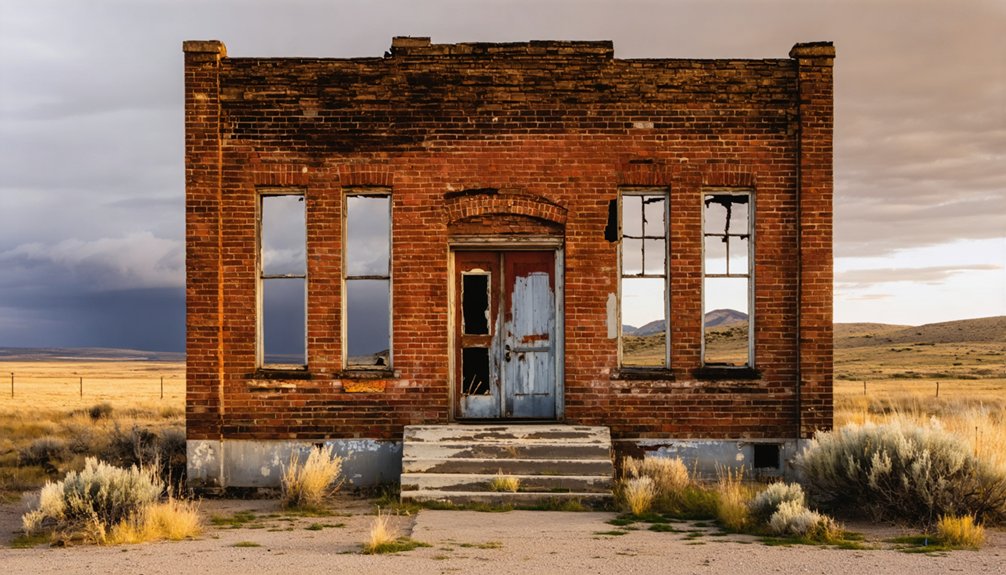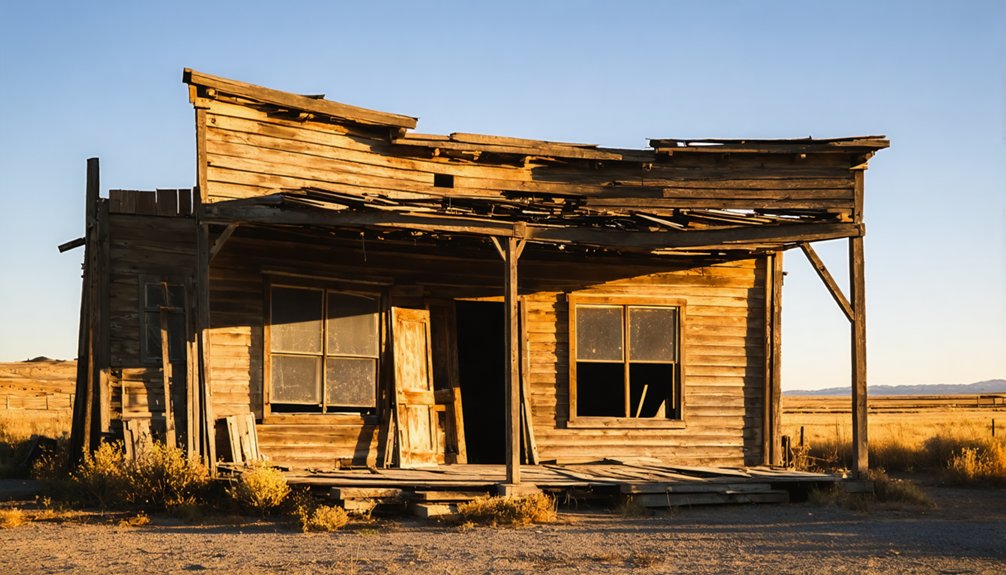You’ll find Keuterville tucked away in Idaho’s Camas Prairie, where German Catholic immigrants established a thriving agricultural community in 1880. The town’s historic Main Street still showcases original 1880s architecture, including the iconic Holy Cross Church that burned twice but was rebuilt each time. While the railroad never materialized and businesses dwindled, this well-preserved ghost town offers a remarkable window into frontier life, where cultural traditions and pioneer spirit endure through preserved buildings and annual celebrations.
Key Takeaways
- Founded in 1880 by German Catholic immigrants, Keuterville became a thriving agricultural community before declining due to unrealized railroad expectations.
- Despite preserving original architectural elements from the 1880s, including the historic Holy Cross Church, Keuterville’s population significantly decreased over time.
- Main Street retains several original structures including the general store, saloons, and dance hall, though many buildings are now vacant.
- The community’s historical significance lives on through preserved buildings and an iconic cemetery containing stories of early settlers.
- Modern Keuterville attracts visitors through winter sports tourism and RV camping while maintaining its status as a living museum of 1880s Idaho.
The Birth of a Frontier Settlement
While many frontier settlements emerged across the American West in the late 19th century, Keuterville carved out its own unique story on Idaho’s Camas Prairie around 1880.
You’ll find the pioneer spirit alive in the tales of German and German-Russian Catholic immigrants who ventured west, seeking fertile soil and the promise of agricultural prosperity. Like the prospectors who found $250 million in gold in Idaho’s Boise Basin, these settlers saw great potential in the land.
Despite the agricultural challenges they faced, these determined settlers built more than just farms – they created a close-knit community ten miles east of Cottonwood.
Their shared Catholic faith and mutual support helped them overcome the isolation of frontier life. Together, they transformed raw prairie into productive farmland, establishing a settlement that would soon boast a bustling main street with essential services for the growing population. Like many of Idaho’s historic remnants, the town’s structures serve as a testament to the resilience of early settlers.
Sacred Heart Church: A Tale of Fire and Faith
As flames engulfed Sacred Heart Church in May 1911, Keuterville’s faithful German-Catholic community faced the devastating loss of their second church building in just 25 years.
You’ll find their church resilience remarkable – after the first church burned in 1886, they rebuilt in 1887, even importing a special altar from Germany. When fire struck again in 1911, they wasted no time constructing their third church.
The fire legacy shaped not just the building’s physical form but its identity too. What started as St. Peter’s Mission evolved into Sacred Heart Church, and finally became Holy Cross Church. While rebuilding, services continued in the 1886 church building.
Through each transformation, the German farming families kept their faith alive, maintaining their cultural traditions and religious practices. Following the example of early Idaho missionaries, they focused on spiritual development rather than material gain.
Today, you can still experience their enduring spirit in the north-south oriented 1911 structure.
Mr. Keuther’s Legacy and Early Development
When Henry Kuther became Keuterville’s first mail carrier in 1888, he never expected a postal service error would immortalize his name differently than intended.
Though initially concerned about his family legacy due to having no sons, Kuther’s influence extended far beyond the misspelled town name when he later fathered two boys.
Keuther’s role in shaping community identity went deeper than mail delivery. As an early settler, he witnessed the town’s transformation from scattered homesteads to a thriving Catholic settlement.
While German farmers from the Midwest built their homes using timber from local mills like Schissler and Forsmann’s, Kuther’s position connected these pioneers through essential communication links. The area’s abundant timber supply had attracted many of these early settlers seeking materials for building and firewood.
His story embodies the spirit of Idaho’s frontier, where individual contributions helped forge lasting communities despite administrative mishaps.
Railroad Dreams and Economic Reality
The promise of railroad connectivity sparked intense speculation among Keuterville’s residents between 1906 and 1907.
Dreams of steel tracks and whistling trains fueled Keuterville’s hopes for prosperity during the railroad fever of 1906-1907.
You’d have found a community buzzing with anticipation, as railroad speculation drove local planning and development. The town’s 8-10 businesses held their breath, hoping for an economic boom that would transform their remote settlement.
The harsh reality of railroad dreams revealed itself through:
- Limited economic diversification beyond agriculture and small businesses
- Over-reliance on speculative railroad routes that never materialized
- Inability to attract substantial industrial development without rail connectivity
Without the promised railroad, Keuterville couldn’t compete with better-connected communities. Like Boise’s early struggles, where residents had to travel from Kuna by stagecoach for transport, the lack of direct rail access severely limited growth potential. Similar to the Oregon Short Line’s bankruptcy in 1893 following the silver market collapse, the town’s economic prospects were deeply tied to unrealized railway development.
You’ll notice how this economic decline mirrors many other Western towns that bet their futures on railroad dreams, only to face the stark reality of isolation.
Main Street Through Time: Historical Buildings
You’ll find Keuterville’s original Main Street business district remarkably intact, with wood-frame structures from the 1880s still standing in their frontier-era locations.
The early commercial zone included Henry Greving’s general store, multiple saloons, Uhling’s butcher shop, and Krieger’s dance hall, creating a self-sufficient hub for the farming community. Like Placerville during its peak, the town boasted thirteen busy saloons. Similar to how modern amenities threaten the historical character of other Idaho ghost towns, Keuterville faces ongoing preservation challenges.
These preserved buildings, which have weathered more than a century of Idaho seasons, offer you an authentic glimpse of how the town’s Catholic settlers established their commercial footprint in the American West.
Original Architecture Remains Standing
Walking down Keuterville’s Main Street today transports visitors back to the 1880s, where original wooden buildings still stand as evidence to Idaho’s frontier history.
You’ll find remarkable architectural significance in these preserved structures, including the Catholic church with its German-imported fixtures and the weathered storefronts that once bustled with pioneer commerce. Early settlers used dirt floors in their cabins as they adapted to challenging frontier conditions.
Despite preservation challenges, the town’s authentic character remains intact through:
- Original wooden saloons and general stores maintaining their historic façades
- The prominent Catholic church, rebuilt after a fire, featuring period-specific construction techniques
- Family homesteads showcasing frontier adaptations like stucco-lined walls and dirt floors
These buildings tell a raw, unvarnished story of rural Idaho life, where settlers carved out their existence using locally sourced materials and simple yet effective building methods.
Early Business District Layout
During Keuterville’s formative years, Main Street evolved into a vibrant commercial hub anchored by Mr. Kuther’s pioneering store in 1888. You’d have found a strategic business clustering of essential services, with John Maugg’s blacksmith shop, Henry Greving’s general store, and Henry Stricker’s hotel forming the backbone of commerce.
The establishment of the post office and townsite patent in 1888-1889 cemented Main Street’s importance as the town’s primary artery. You would’ve experienced a walkable corridor where social hubs like Waldmann’s saloon and Krieger’s dance hall intermingled with practical services like Uhling’s butcher shop.
This compact layout served the diverse needs of settlers, miners, and families, though fires in 1886 and 1911 periodically challenged the district’s development.
Historical Preservation Since 1880s
Since its establishment in 1880, Keuterville’s Main Street has preserved much of its original architectural heritage, with several notable 19th-century structures still standing today.
You’ll find that the historical significance of these buildings reflects the town’s journey through time, from its hopeful beginnings to its current revival efforts.
The community’s engagement in preservation has focused on three key elements:
- The iconic Catholic Church built in 1884, featuring authentic German fixtures
- The original saloon and general store, which maintain their 1880s facades
- Historic family homesteads that tell the story of early settlers
Today, you can experience this living history firsthand as you explore Main Street’s preserved buildings, which continue to serve as anchors for the town’s winter sports tourism and RV park initiatives.
German Heritage in the Idaho Wilderness

You’ll find the soul of Keuterville in its German Catholic heritage, which took root when settlers from the American Midwest arrived in 1880 to establish a new community in the Idaho wilderness.
The town’s first Catholic church, built in 1885, became the cornerstone of German cultural life, drawing more immigrant families to the area through established pioneer trade routes.
The original buildings and traditions of these German settlers have endured through fires and challenges, with the historic church still standing as a symbol of the determination of Keuterville’s founding families.
German Catholic Church Heritage
While pioneers carved settlements across Idaho’s rugged wilderness in the 1880s, German Catholic immigrants established a spiritual stronghold in Keuterville that would shape the region’s cultural landscape for generations.
You’ll find their legacy in Holy Cross Church, which has risen three times from humble beginnings – first as a simple structure where you’d see parishioners kneeling at makeshift pews, then rebuilt in 1897, and finally restored after a devastating 1911 fire.
- Catholic traditions flourished even without a permanent priest, as families gathered for prayer and worship.
- Community gatherings centered around the church’s German-made altar, brought from their homeland.
- Annual parish dinners each March continue to unite descendants of those original settlers.
The church stands as a symbol of their determination to preserve their faith and culture in Idaho’s frontier.
Early Immigrant Trade Routes
The paths that brought German settlers to Keuterville intertwined with Idaho’s earliest trade routes, stretching far beyond the church’s sacred grounds.
You’ll find these immigrant pathways following the same corridors that fur traders blazed in the early 1800s, including routes through what’s now the Boise National Forest.
If you’d traveled these trade connections in the 1860s, you’d have witnessed German miners, farmers, and craftsmen making their way into Idaho’s wilderness.
They often followed Goodale’s Cutoff or branches of the Oregon Trail, though many chose to settle rather than continue westward.
These determined pioneers transformed what others saw as barren landscape into thriving farmland, establishing essential trade networks that connected their new settlements to the region’s emerging markets.
Cultural Traditions Still Standing
Standing at the heart of Keuterville’s enduring German heritage, Holy Cross Church has anchored cultural traditions since its first construction in 1886.
You’ll find a rich tapestry of German Catholic customs that have survived through generations, from traditional feast days to community rituals that bind families together.
- Annual cultural celebrations like St. Mary’s/Holy Cross Dinner and Raffle continue to honor immigrant roots
- German Catholic festivals, including the Feast of St. Nicholas, preserve old-world traditions
- Community gatherings feature traditional religious music, prayers, and communal meals
Despite fires that ravaged the church in 1886 and 1911, the congregation’s spirit remained unbroken.
You can still experience this heritage through the church’s German-crafted altarpieces and the rhythms of seasonal festivities that connect modern residents to their pioneering ancestors.
The Impact of Health Crises and Community Response

During the early years of Keuterville’s development, devastating health crises, particularly a severe typhoid fever outbreak, reshaped both the town’s population and its social fabric.
The lack of health infrastructure forced residents to rely on community resilience and mutual support networks to survive. You’ll find evidence of this solidarity in how Mr. Barney Luchtefelt donated land for a cemetery to bury typhoid victims, and how the Catholic Church served as a crucial support center during emergencies.
The town’s response to these challenges reflected remarkable adaptability. Local businesses, including the general store and post office, maintained essential services despite population decline.
Through their ethnic and religious bonds, settlers created informal healthcare networks, though the railroad’s bypass of Keuterville ultimately limited access to medical supplies and personnel.
A Century of Cultural Preservation
You’ll find Keuterville’s German Catholic heritage endures through the preservation of St. Mary’s Church, a symbol of the town’s spiritual and cultural foundations.
The church’s striking Gothic architecture and ornate altar, brought by the original German settlers in 1895, continue to draw visitors and historians interested in Idaho’s religious history.
Local preservation groups have worked tirelessly to maintain both the physical structure and the cultural traditions, including the annual Corpus Christi celebration that has occurred uninterrupted for over a century.
German Heritage Lives On
While many Idaho ghost towns have lost their cultural identity over time, Keuterville’s German heritage continues to thrive through its preserved traditions, religious practices, and community spirit.
You’ll find the heart of German traditions beating strong at the Holy Cross Church, where altars imported from Germany still stand as evidence of the town’s rich cultural heritage.
Experience the enduring legacy through:
- Annual cultural celebrations like Oktoberfest and the St. Marys/Holy Cross Dinner and Raffle
- Preserved German farming techniques and work ethics passed down through generations
- Religious customs that maintain the authentic spirit of early German Catholic settlers
The surnames of founding families like Kuther and Maugg still echo through the region, while imported fixtures and artifacts remind you of the deep connection between this Idaho town and its German roots.
Preserving Sacred Religious Landmarks
Since its establishment in 1884, Keuterville’s Holy Cross Church has stood as a monument to religious devotion and cultural preservation.
You’ll find its original fixtures were imported from Germany, though they were lost when the first church burned down. The community’s resilience shone through as they rebuilt, creating the sacred space that still stands today.
The adjacent cemetery, donated by Barney Luchtefelt, holds the stories of early settlers and those lost to typhoid fever.
Like the nearby Monastery of St. Gertrude, these landmarks preserve more than just buildings – they maintain living traditions. You can still witness daily prayers and sacred ceremonies that have continued for over a century, connecting today’s visitors with the spiritual practices of Idaho’s pioneers.
The church remains Keuterville’s enduring symbol, even as the town itself faded into history.
Modern Adventures in a Historic Setting
Exploring Keuterville’s historic streets today offers a unique blend of past and present adventures. You’ll find yourself walking the same paths as 1880s settlers while discovering modern recreational opportunities.
Step into Keuterville’s timeless streets, where pioneer footsteps meet modern adventures in an Idaho time capsule.
The town’s original main street buildings stand as silent witnesses to local folklore, inviting you to imagine the bustling days of blacksmith shops and hotels.
- Trek through preserved historical sites, including family homesteads and the iconic Catholic church.
- Experience seasonal adventures from summer RV camping to winter snowmobiling.
- Navigate the 2WD-accessible roads that connect you to hunting grounds and hiking trails.
While Keuterville may be considered a ghost town, it’s experiencing a renaissance through winter sports and tourism.
The blend of historical architecture and outdoor recreation creates an authentic Idaho adventure that’s both educational and liberating.
Exploring Yesterday’s Streets Today
Today’s walk down Keuterville’s main street reveals an authentic slice of 1880s Idaho, where original commercial buildings from the town’s founding still stand sentinel.
You’ll find the old saloon, hotel, and general store exactly where frontier lifestyle once flourished – proof of the community resilience that defined early settlers.
As you explore, you’re tracing the footsteps of pioneers like Mr. Kuther, John Maugg, and Henry Greving, whose businesses shaped this rural outpost.
The Holy Cross Church, rebuilt after two fires, showcases imported German craftsmanship that early residents prized.
Just beyond town, the historic cemetery tells silent stories of typhoid outbreaks and hardy homesteaders.
While the railroad boom never materialized, Keuterville’s unchanged layout offers you a genuine window into Idaho’s agricultural past.
Frequently Asked Questions
What Happened to Mr. Keuther After Founding the Town?
You’ll find Mr. Keuther’s legacy continued quietly after town founding, as he ran the local store and postal service into the 1890s, though specific details of his later life remain historically scarce.
Are There Any Living Descendants of Original Keuterville Settlers Today?
While local records suggest over 80% of mining town families dispersed, you can’t definitively confirm living descendants of original Keuterville settlers today. No documented descendant stories or family legacies exist in public records.
What Was the Peak Population of Keuterville During Its Heyday?
You’ll find historical records don’t specify exact numbers, but based on ghost town history and population decline patterns, Keuterville’s peak likely reached between 50-200 residents during the 1880s farming community era.
Does Anyone Maintain the Historic Buildings in Keuterville Now?
You won’t find active historic preservation or organized building maintenance happening there now. The structures are largely left to natural decay, unlike some of Idaho’s better-maintained ghost towns under government protection.
When Was the Last Time Keuterville Had an Operating Business?
Time flies, but you’d find the Keuterville Pub LLC was operating as recently as the early 2020s, marking the latest chapter in this town’s business history before its continued economic decline.
References
- https://idaho.idgenweb.org/Town History/keuterville_idaho_county.htm
- https://www.youtube.com/watch?v=qETuUsWjeW8
- https://www.ghosttowns.com/states/id/keuterville.html
- https://idaho-forged.com/idahos-ghost-towns-eerie-yet-approachable/
- https://history.idaho.gov/wp-content/uploads/2018/08/0064.pdf
- https://ewgs-spokane.blogspot.com/2021/06/keuterville-idaho-anybody.html
- https://en.wikipedia.org/wiki/List_of_ghost_towns_in_Idaho
- https://visitidaho.org/things-to-do/ghost-towns-mining-history/idaho-city-historical-area/
- https://www.legendsofamerica.com/idaho-city-idaho/
- http://www.llystwrog.com/50plusdc/html/body_idghosttowns.html



